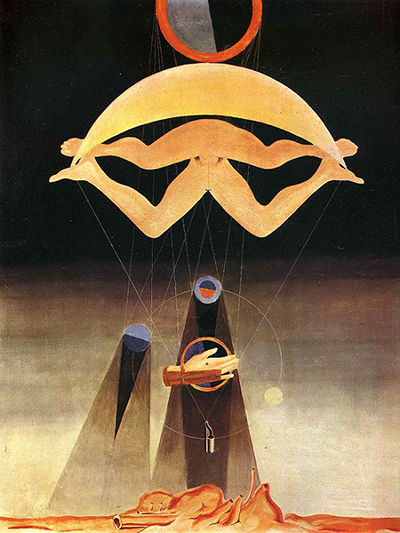Of This Men Shall Know Nothing, an oil on canvas painting, was executed by Max Ernst in 1923. It is housed at Tate Liverpool and measures 81 by 64 centimetres.
The artist produced the painting in a Surrealism style as it's a symbolic painting. It shares some features with Silberer’s diagram: The inclusion of the moon and the sun, the sky gradation from dark at the top to light at the bottom as well as its low horizon and landscape setting. The artist used a pile of entrails to substitute for the cube of Primal Matter. Elsewhere, he also used alchemical motifs; for instance, in the picture of the sexual connection of Sun and Moon.
These two principles demiurge - the moon and the sun - are divine architects. Their lines of creation dart down from their heavenly home to display on the plane of reality. The lines from the sun in the painting form the robed figures with their naked bodies hidden from sight. The lines coming from the moon, on the other hand, are leading to the phallic whistle, which is linking it to sexual principles that are represented by the figures that are having sexual intercourse hidden by the moon.
Ideas of Bréton's Marvellous is seen in this painting as it has occult iconography. In the painting, the spheres that form the highest percentage of the painting connect it to Cabbalistic mysticism - a unifying occult form liked to Alchemy, Platonism and Hermeticism including Rosicrucianism.
At the top of the painting, there is a sun that's halfway through its eclipse period. The solar eclipse is a symbol of the struggle between two sides of a person. The eclipsing unconscious, which is the Dionysian perspective of the real and self, conscious, Apollonian self. In the artwork, the sun is surmounting an inverted crescent moon that's hiding 2 mating figures from its sight. This suggests a link between the lunar (unconscious, female) principle and concealed sexual knowledge that played a role in the falling of man from grace. This fall represents nature and mankind fall into matter.
The fall protects man from the spirit world and a seemingly bottomless chasm opens between man and divine. At the bottom of this artwork, there are measuring cylinder, tubes, beakers and covered in clay, dirt and mud. This is alchemy representational and the occult mysteries laced with it suggests the use of Rosicrucian and alchemical imagery as a rebellious structuring device for making art.




